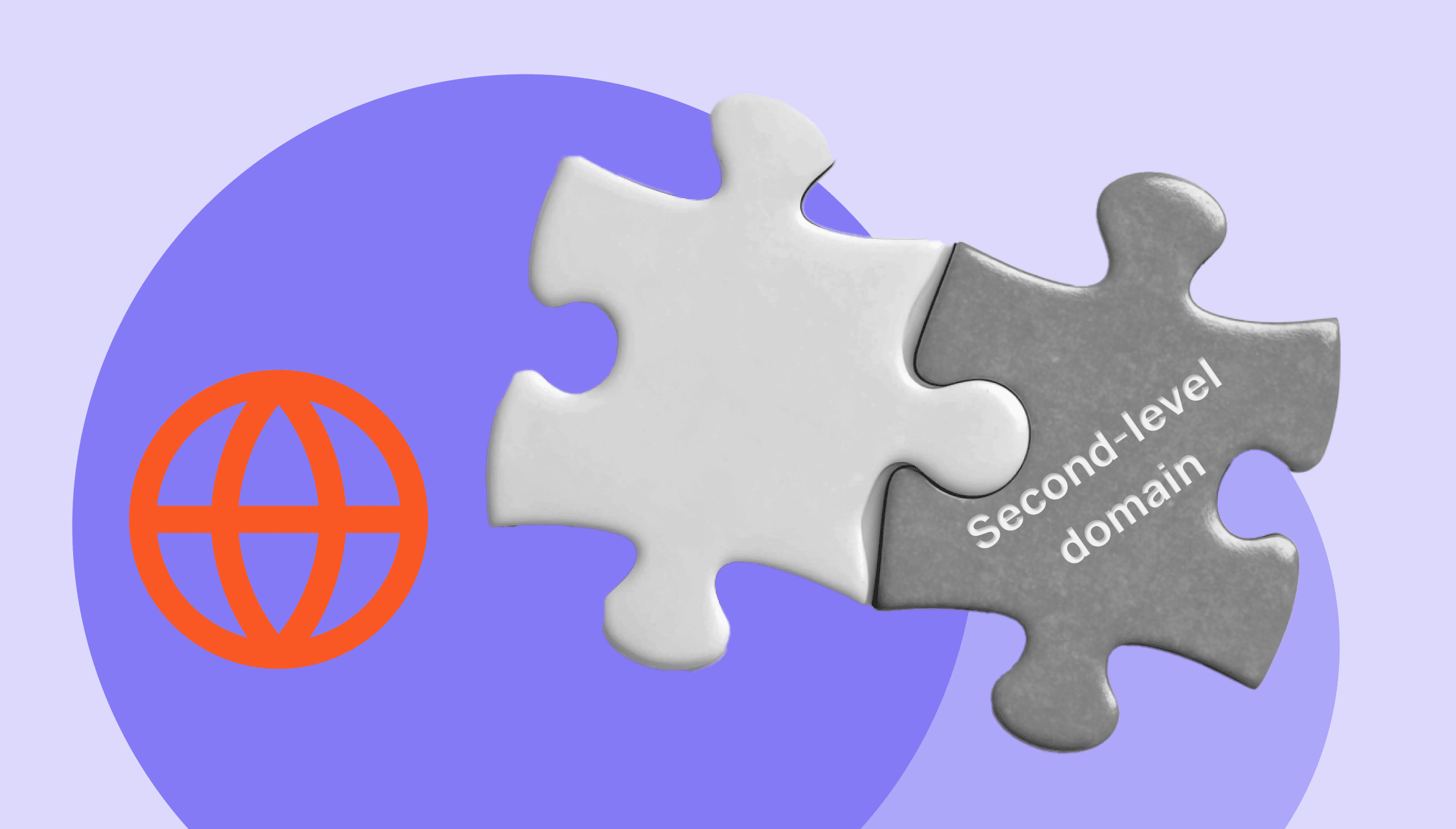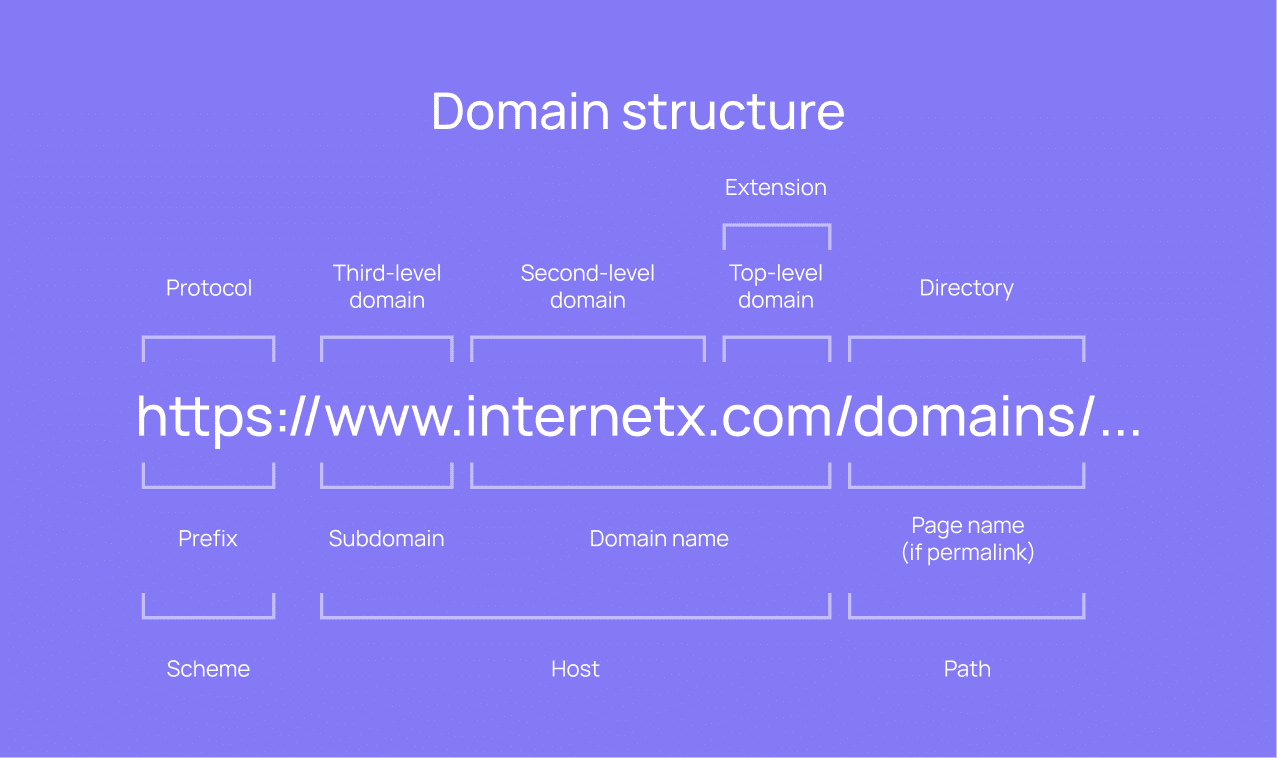
What is a second-level domain?

Second-level domains are the backbone of every web address, sitting before the extension. Discover why they matter and how they shape your online identity.
Published by

Simone Catania
Date
A second-level domain (SLD) is the part of a domain name that appears immediately to the left of the top-level domain (TLD). For example, in internetx.com, the word “internetx” is the second-level domain, while .com is the top-level domain. Together, they form a complete and functional domain name.
Second-level domains carry weight in terms of brand recognition, search visibility, security and digital trust. Choosing the right SLD can define your digital strategy for years. And for DNS operators and domain managers, understanding the nuances of SLDs is essential to keep networks resilient, secure and, of course, compliant.
As a knowledge hub, Snapshot by InterNetX brings clarity to domain-related topics. Here, we focus on the second-level domain — a concept that’s simple on the surface, but rich with implications across internet infrastructure.
What is the DNS and how do second-level domains fit in?
The Domain Name System (DNS) is a distributed database that maps domain names to IP addresses. Without DNS, users would need to type long numeric IP addresses to reach websites. Instead, DNS allows for intuitive, memorable names.
The DNS is organized into zones, each responsible for a portion of the namespace, which ensures scalability and redundancy. It is organized in a hierarchical structure, much like a tree. At the very top is the root zone, which branches into top-level domains (TLDs) such as .com, .org, or country codes like .de.
Just beneath the TLD sits the second-level domain (SLD)—for example, internetx in internetx.com. The SLD is what gives each domain its unique identity, as it is the part chosen and registered by the domain holder. From there, additional levels like subdomains (e.g., www.internetx.com or snapshot.internetx.com) can be created, but the SLD remains the anchor point that connects the chosen name to the broader DNS hierarchy.
Breaking down a domain name
From right to left, domain names are divided into levels:
- Top-level domain (TLD): This is the extension at the end of a domain name, such as .com, .org, .net, or ccTLDs like .de, .fr, or .uk. TLDs are managed by organizations called registries, which maintain the central database for all domains under that extension. They define the rules for registration and ensure the stability of their namespace.
- Second-level domain (SLD): The component directly to the left of the TLD. In internetx.com, the SLD is internetx. The SLD is the part chosen by the registrant and forms the unique identity of the domain name. It is the core element of brand visibility and recognition, and once registered, it becomes the anchor for all associated services such as websites, email, and DNS records.
- Subdomain: Optional subdivisions created under the SLD. In snapshot.internetx.com, snapshot is the subdomain. Subdomains are often used to organize content or services. They provide flexibility without requiring additional domain registrations.
- Hostname: This identifies the specific server (usually the web server) that users reach when they type www.internetx.com. So in this case, “www” is the hostname within the fully qualified domain name (FQDN) www.internetx.com. Hostnames can point to web servers (www), mail servers (mail), or other services. In technical terms, hostnames are tied to DNS records (like A or CNAME records) that map them to an IP address, ensuring users can reach the correct server.
This order enables DNS queries to cascade through the hierarchy efficiently, starting from the DNS root zone and moving downwards.

Overview of second-level domains (SLDs)
| Aspect | Details |
| Definition | The part of a domain name directly to the left of the TLD. Example: in internetx.com, internetx is the SLD. |
| Position in DNS | Sits below the top-level domain (TLD) and above any subdomains. |
| Chosen by | Registrant (domain owner), when registering a domain through a registrar or reseller. |
| Managed by | Registrars (front-end) and registries (back-end), under ICANN or national authorities in the case of ccTLDs. |
| Role in DNS | The anchor of DNS resolution; determines which DNS records (A, MX, CNAME, TXT) apply to the domain. |
| Use cases | Branding and identity, localized versions under ccTLDs (e.g., brand.de), marketing campaigns, personal websites, or defensive registrations. |
| Special forms | Country-code second-level domains (ccSLDs) such as .co.uk, where registration happens at the third level. |
SLD vs. TLD: What is the difference?
A top-level domain (TLD) is the extension at the far right of a domain name, such as .com, .org, or ccTLDs like .de or .fr. TLDs are managed by organizations called registries under the oversight of ICANN or national authorities.
A second-level domain (SLD) is the part directly to the left of the TLD—for example, internetx in internetx.com. The SLD is chosen and registered by the registrant (the domain owner) through an accredited registrar or domain reseller.
When combined, the SLD and TLD form a registered domain name (e.g., internetx.com).
Functional role of second-level domains
The second-level domain (SLD) is a core element of the DNS that impacts everything from user experience and day-to-day operations to branding and security.
Branding and identification
For most organizations, the SLD represents their digital identity. It is often identical to their business or product name, forming the first point of contact with customers. A strong SLD:
- Builds recognition: Users remember short and meaningful one word domains more easily than a long or complex URL.
- Drives trust: A clear, recognizable SLD reassures visitors they are on the official site.
- Supports marketing: Campaigns across email, print and digital all depend on how memorable the SLD is.
For example: internetx.com is short and memorable. A name like internetx-domain-registrar-online.com isn’t and is easier for others to make similar-looking fake sites.
How does a second-level domain work in DNS resolution?
When you type a domain name like internetx.com into your browser, the TLD (.com) tells the system where to start looking, but it’s the SLD (internetx) that actually directs traffic to the right place. The SLD is the key identifier in DNS resolution, since it points to the exact domain within a TLD.
When a user enters internetx.com:
1The query starts at the root DNS servers, which direct it to the .com TLD nameservers.
2The TLD servers then refer the query to the authoritative nameservers for the SLD internetx.
3Those nameservers contain the zone file that maps internetx.com to its corresponding IP.
The label “internetx” by itself isn’t unique. Pair it with a TLD and you get different domains: internetx.com and internetx.eu are separate domain names in separate zones, with their own records.
How the SLD connects to DNS records
When you register a second-level domain (SLD) under a TLD such as internetx.com, you gain control over the DNS zone for that domain. This zone is where you configure DNS records, which act like instructions telling the internet how to handle traffic associated with your domain. This means that the SLD serves as the foundation, while DNS records define how your domain functions across the web. For instance,
- A/AAAA records connects your SLD to a specific IP address, ensuring visitors land on the right server.
- MX records directs email traffic so that messages sent to addresses like mail@example.comreach their goal.
- TXT records store text-based information, often used for security and verification—like proving domain ownership for Google Workspace or enabling email authentication standards such as SPF, DKIM, and DMARC.
- CNAME records allows you to alias one domain to another, such as pointing www.internetx.com to internetx.com without needing a separate server.
Country-code second-level domains (ccSLDs)
Country-code second-level domains (ccSLDs) represent a special use of second-level domains, where registrations are restricted to specific predefined categories beneath a country’s top-level domain. The most well-known example is the .uk namespace, which traditionally allowed registrations only at the third level, such as .co.uk or .org.uk, rather than directly under .uk. Similarly, Australia followed this model for many years, requiring domains to be registered at the third level (e.g., .com.au). However, from March 2022, Australia revised its policy and opened direct registrations under .au, offering shorter and more flexible domain options.
ccSLDs add an extra structural layer to domain naming, often driven by national policy decisions and local internet governance practices. ccSLDs offer several advantages by providing a clearer structure and categorization of domains, such as distinguishing commercial sites (.co.uk) from non-profits (.org.uk). They also strengthen trust and local identity, as users can instantly recognize the type and purpose of a website within a national context. Additionally, ccSLDs help regulators and registries maintain order and oversight, ensuring domain usage aligns with local policies and standards.
SLDs and premium domains: When a name becomes an asset
Not all second-level domains (SLDs) are created equal—some are considered premium domains because of their high market value. These SLDs are often short, keyword-rich, or highly brandable terms that are easy to remember and type, such as travel.com or shop.de. Their scarcity and marketing potential make them digital assets, sometimes selling for thousands or even millions of dollars.
For businesses, investing in a premium SLD can mean instant credibility, stronger search visibility, and a competitive advantage online. In this way, the choice of an SLD goes beyond technical configuration—it can become a cornerstone of brand strategy and long-term digital growth!
Security considerations
SLDs are high-value targets for attackers. DNS operators must harden their domains against multiple threat vectors:
- DNSSEC: Without cryptographic signatures, DNS records can be tampered with en route (cache poisoning). DNSSEC validates domain queries against a chain of trust.
- Email authentication: Since email spoofing is a major cyber threat, domain operators should configure SPF, DKIM, and DMARC records. Together, these records verify legitimate senders, reduce spam and protect brand reputation.
- Registrar locks and monitoring: Attackers often attempt domain hijacking by transferring ownership. Registrar locks prevent unauthorized changes, while monitoring services alert operators to suspicious modifications.
The strategic power of SLDs in the internet ecosystem
The second-level domain may appear as just one element in the DNS hierarchy, but it is foundational to the technical, strategic, and branding aspects of the internet. From facilitating DNS resolution to serving as a brand’s digital identity, the SLD carries operational and symbolic weight.
While the internet will continue to evolve with new TLDs, technologies, and policies, the role of the SLD as the centerpiece of a domain name will remain constant—anchoring the way we navigate and experience the web.
Find perfect domains






